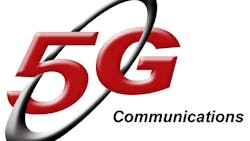Q&A: Freescale’s Rouwet and Alcatel-Lucent’s Urie Discuss 5G
This file type includes high resolution graphics and schematics when applicable.
Ready for 5G? I talked with Wim Rouwet, senior systems architect in the Digital Networking group of Freescale Semiconductor, and Alistair Urie, Architecture Strategy Director and lead for 5G Strategy at Alcatel-Lucent, to get a deeper perspective on 5G.
Wong: What is 5G? How do you define it?
Rouwet: 5G is the term used by the industry to capture the telecommunications network as it is envisioned to be used in 2020 and beyond. This is the follow-up from the “4G” (also known as LTE) network we have today, and before that, “3G” (WCDMA, CDMA2000) and “2G” (GSM, CDMA) networks. 2G and 3G networks were focused on delivering voice (2G) and basic data (3G) capabilities. In 4G, data capabilities were drastically expanded to provide an end-user experience that competes with basic wired networking services.
: 5G aims to expand end-user service capabilities to support a wider range of new use cases, in addition to improving the data capabilities of the best-effort Internet service. The additional use cases supported by 5G call for new network capabilities, such as 1000x mobile data volumes, a 10x to 100x increase in end-user devices, and a lower communication latency (by 5x).
Wong: When do you think we’ll see the first deployments of true 5G? Why?
Urie: Just as we saw in the early “4G” deployment days, the rollout will probably be a gradual process, with first movers expected to launch 5G service in 2020 after one or more years of trials and technology demonstrations, and then wider adoption around the global over the following years. In parallel, we expect LTE will continue to evolve with new features, such as higher-order MIMO, larger carrier aggregation sets, and extensions to improve coverage, cost, and battery life for Internet of Things (IoT) devices.
Wong: What is the biggest challenge 5G faces today and how can that be overcome?
Urie: There are many challenges to overcome for 5G development. A big one will be the definition of a new radio interface operating in a normal cellular band to provide wide area coverage of 5G use cases that cannot be offered via backwards-compatible evolution of LTE. We expect this new radio interface would be used as the “primary carrier” for 5G-capable devices, with the installed base of LTE and Wi-Fi carriers used to provide capacity for both 4G and 5G devices. Eventually, we expect that a new 5G carrier, operating in a higher frequency band located somewhere above 20 GHz in the so-called millimeter-wave (“mmWave”) bands using a massive MIMO antenna system, will be deployed in dense urban areas to provide extreme local capacity to 5G devices. The overall radio concept for 5G is therefore a pair of “low” and “high” band 5G carriers combined for LTE and Wi-Fi access to offer a seamless end-user experience that supports the full range of 5G use cases.
Rouwet: There probably won’t be a “silver bullet” air interface that solves all use-case challenges. Instead, we envision that different use cases will drive a multitude of air-interface standards. Think of a combination of Wi-Fi (short range, high throughput), evolution of existing LTE standards (e.g., large-scale MIMO deployments), millimeter-wave wireless access for low-mobility/high-throughput scenarios, and a low-speed/energy optimized access method for enabling IoT. At some point in the data-processing chain, all of these standards will need to interoperate efficiently. A key tool to build this network will be software-virtualization techniques (SDN and NFV), which allow you to efficiently host multiple stacks and applications in a single device or architecture.
Wong: What are you most excited about regarding 5G?
Rouwet: 5G offers the promise of a true “always on” user connection, where you no longer need to worry about what specific air interface is enabling your digital experience, and where that air interface is matched to your requirements in such a way that you don’t have to recharge your battery all the time.
Wong: How will standards impact the development of 5G?
Urie: Standardization for 5G technologies has just started with initial work in 3GPP and ITU-R on requirements. 3GPP is expected to then complete detailed radio and network specifications work between now and 2018. One key contribution to the initial task of setting requirements has been the publication of the NGMN (“Next Generation Mobile Networks”) 5G white paper, which sets out 5G use cases and proposes a high-level timeline.
Rouwet: Right now, different vendors are working on pre-standardization R&D work through projects in Europe, Asia, and the Americas. Some prototypes of “5G technology drivers” (such as virtualization, mmWave radios, and a proposed new waveform for 5G access) have been shown at events like the 2015 Mobile World Congress. But, realistically speaking, there’s still a lot of work to be done on the standardization side, especially taking into account the alignment of multiple different radio technologies. It’s an exciting time to be working in this field right now!
Wong: How will 5G impact consumers? What will 5G allow that isn’t possible with 4G?
Urie: To consumers, 5G will provide that always-on seamless experience that we talked about before, but now with a more consistent performance and reduced radio interface latency. In parallel, 5G will also act as an enabler for new applications, such as massive connectivity for the IoT, extremely low latency bearers for specialized services, and new solutions to offer mobile broadband services into markets for lower average revenue per user (ARPU).
This file type includes high resolution graphics and schematics when applicable.
Rouwet: One interesting impact of 5G will be that the end users will be less aware of which specific underlying technology is used, but more aware of the overall experience, where information technology will be embedded into our daily routine even more than it is today. Expect all kinds of new applications to be developed that make your life more convenient, using lower latency and faster data pipes that connect yourself and every device nearby you. Autonomous driving is a great example of such an experience, and the timeline for introduction of this is much aligned to 5G!
About the Author
Wim Rouwet
Senior Systems Architect, Digital Networking Group
Wim Rouwet, a senior systems architect in the Digital Networking group of Freescale Semiconductor, has a background in network processing, wireless and networking protocol development, and systems and architecture, focusing on wireless systems. His experience includes hardware and software architecture, algorithm development, performance analysis/optimization and product development. He holds a master's degree in electrical engineering/telecommunications from Eindhoven University of Technology.



